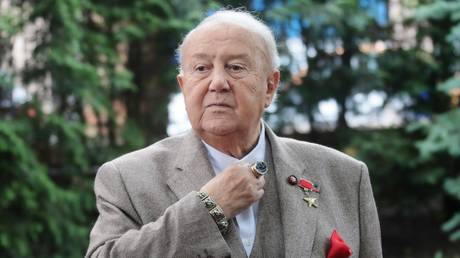What the Biden administration isn't telling Congress about spy balloons
Officials inside the Pentagon and intelligence community still haven’t answered questions about what they know about foreign objects floating in U.S. airspace.


Lawmakers have been asking the Biden administration for weeks for details about hundreds of aerial objects floating in U.S. airspace and how many of them may be foreign surveillance tools. They haven’t gotten much of an answer.
One reason: The administration is still trying to determine how bad the problem is.
Even in classified briefings, officials working on the issue inside the Pentagon and the intelligence community have yet to answer key questions. Those include how many foreign surveillance balloons the U.S. has identified in the past, what sort of tracking the current detection system allows and why the Chinese spy balloon the administration shot down in February required more action than previous ones, according to a U.S. official and two congressional aides. All were granted anonymity to speak freely about a sensitive national security matter.v
The administration has been slow to respond in part because officials are still reviewing the historical data on the unidentified aerial phenomena, also known as UAPS, and are running into problems trying to retroactively determine whether past sightings were surveillance tools or other objects such as academic weather balloons, according to the official. The information officials are using for their analysis is at times dated and incomplete.
The delay by the administration on releasing information about the Chinese balloon and the other objects shot down last month raises questions about the extent to which the U.S. fully understands what intelligence foreign governments may be collecting without Washington’s knowledge.
“What is our capability to observe what's in our airspace? There's holes in it. We should understand what we can and cannot observe and understand what we need to do to be able to fill those gaps,” said Tim Gallaudet, the former administrator of the National Oceanic and Atmospheric Administration. “The balloon surprising us — it was a big wake up call.”
Members of Congress say they are pushing the administration to improve the way it collects and analyzes UAP data.
“We can't tell based on the data we have – based on the photographs or the video or the radar we have – whether it was a drone or a balloon, whether it was an aircraft,” said Sen. Kirsten Gillibrand (D-NY) of difficulty in identifying some of the previously detected unidentified aerial objects. Gillibrand wrote legislation to help fund better investigations of these objects.
The National Security Council and the Office of the Director for National Intelligence declined to comment. A second senior U.S. official presented the administration's stance, arguing that it has a good sense of how foreign governments are trying to surveil from the air but that it is still trying to determine whether hundreds of UAPs are spy tools or benign objects. The administration has shared with Congress in recent weeks a policy plan that will guide how it responds to aerial objects in the future, the official said.
When the Chinese balloon appeared over the U.S. in late January, officials described it as a surveillance device and said it had lingered over sensitive military sites, forcing the administration to shoot it down a week later. Officials also said that Chinese surveillance balloons had transited the U.S. at least three times during the Trump administration.
In the days that followed, three other aerial objects appeared over North America and the administration shot those down, too, even though officials said they posed no security threats.
Lawmakers say the administration has not made clear to Congress why it decided to start downing the UAPs.
Sen. Mark Warner (D-VA) said he was not surprised that China used a balloon to spy on America. What was frustrating, he said, was that when it came to the Chinese spy balloon, it appeared “we didn't have, at that point, a clear policy on what to do.”
Journalists and lawmakers pressed the administration for answers: Why did this particular Chinese balloon require a public response? And if the U.S. was worried about this one balloon, how many others have potentially already obtained imagery and other sensitive details about American military installations?
Officials at the North American Aerospace Defense Command, which shot down the Chinese surveillance balloon, have said that there was a “domain awareness gap” when it came to the office’s detection of balloons during the Trump administration and the early days of the Biden administration.
And in a congressional hearing March 8, Gen. Glen VanHerck, the commander of NORAD, said the three objects shot down in the days following the emergence of the Chinese spy balloon “clearly demonstrated the challenges associated with detecting and identifying unmanned objects in U.S. airspace.”
“I commit to you that this event has already generated critical lessons learned for my commands and our mission partners,” he said.
But officials have so far not provided details about current U.S. gaps in detection. Lawmakers want to know, for example, whether the radar and sensors the U.S. had in place prior to the shooting down of the Chinese surveillance balloon allowed for officials to see the full-range of objects floating above commercial airspace.
Susan Gough, a spokesperson for the Pentagon’s All-domain Anomaly Resolution Office — the team that investigates unidentified flying objects and other phenomena in the air — said the office is “reviewing the associated data of all past cases” in a “newly developed analytic framework.” Gough declined to provide details on the specifications of that framework but said AARO is working to “fill existing gaps.”
“UAP are objects that cannot be immediately identified and may exhibit anomalous behavior. Anomalous behavior means that DoD operators or sensors cannot make immediate sense of collected data, actions or activities,” Gough said.
An unclassified report from the Office of the Director for National Intelligence from last year said that there are at least 171 “uncharacterized and unattributed UAP reports.”
Many of the UAP reports came from Navy and the Air Force pilots who witnessed the aerial objects while flying, the report said. The U.S. also uses radar to detect the objects, but that often doesn’t provide enough detail to identify clearly what type of object it is.
It’s not clear whether the problem is simply about the limits of technology, or also about how the Pentagon and other agencies have decided to prioritize and parse data.
Gillibrand said there is a push among some officials and lawmakers to have “longer-term, more persistent awareness” of the area above commercial airspace to better track drone and balloon technology.
However, the administration has yet to decide how and whether to rejigger its approach to tracking and shooting down the objects, including whether it wants to set new thresholds in its systems that would allow for officials to more easily detect a larger number of UAPs at any given time. Those discussions have been viewed internally as slowing down the analysis of historical UAP data, the official said.
Lawmakers are actively pushing for more information from the administration. The Senate plans to hold a public hearing on the topic in April.
It's unclear how forthright the administration will be in its conversations with Congress about its investigative work. National Security Council spokesperson John Kirby told reporters on March 7 that “there might be very little at all” that the administration can reveal about the Chinese balloon debris collection efforts. "I've set no expectation that there's going to be some big public rollout of what we've learned,” he said.
Discover more Science and Technology news updates in TROIB Sci-Tech












